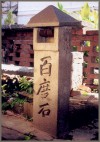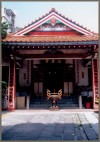 |
 |

Founding Year : 1919
God Worshipped : Guanyin Bodhisattva (Birth date : February 19)
Religion : Buddhism
Relic Classification : Not yet classified
Location : 194, Hsining S Rd, Wanhua District, Taipei
Phone : (02) 23318424
|
|
|
|
|

Built in 1919, Fa-hua Shih is a typical old temple of the Japanese occupation period. Inside the Temple is a drum on which are characters "祈家運榮昌" (meaning "Wish the Family Prosperity") and the name of a Japanese "岡田榮源" (Okata Eigein), who was probably the first abbot of the Temple. Born in 1893 and died in 1943, Okata Eigein came from Osaka, Japan; his original last name was "Kimura". When young he studied Buddhist sutra at Miao-shing Temple in Okayama Prefecture under Abbot Okata Nichihio , who later adopted him as a son. Consequently, he changed his last name to "Okata" and used "Eigein" as his Buddhist name. He was the founding supervisor of Nichiren Shenshu in Taiwan.
After Taiwan Retrocession, the Japanese-style temples gradually decayed and disintegrated. The Fa-hua Shih was renovated in 1989. The plaque contributed by Miao-hsing Temple of the Okayama Prefecture is now still hung inside the wall of the Fa-hua Shih.
|

 |

The Temple primarily worships Guanyin Bodhisattva, and secondarily Amitabha and Ti-chang-wang Buddha. Since Guanyin Bodhisattva has been introduced previously, to be introduced here is Amitabha. The name "Amitabha" is derived from Sanskrit "Amitayus". Amitayus Buddha (birth date: November 17) was used to be a king before he became a monk. After becoming a monk, he wished forty-eight great wishes, wishing to establish a Paradise Land. Later he became the founder of the Buddhist Paradise. According to the Buddhist sutra, the Paradise is sacred clean land, where there is happiness and no miseries. Everywhere in Taiwan, be it in the village, country, remote mountain, seacoast, people often see a poster with the words "Amitabha Buddha" pasted on the electrical polls, branches, or walls.

From the name "Fa-hua Shih" we can surmise that it is related to "Fa-hua Ching" (Ching means sutra or scripture) and "Miao-fa-lien-hoa Ching." Therefore, nearby the gate of the Fa-hua Shih stands a 2-meter high rock, on which is an inscription of seven characters "Nan-wu-miao-fa-lien-hoa Ching ". The religious sects based on "Fa-hua Ching" are in China the "Tien-tai Chung," and in Japan, the "Nichiren Shenshu." Up to the present, Fa-hua Shih still keeps the appearance of a Japanese Buddhist temple. Inside the Temple is a stone plate which, set up in 1936, has an inscription of three words---- Pai-tu She---- on it.
|
| |
|
|
|